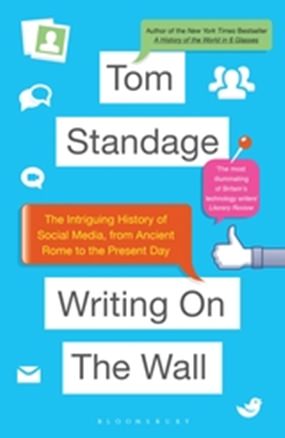 I
am not a lover of FaceBook. I do not have a Twitter account. So when I spied
Writing on the Wall on the Bookazine shelves which on its front cover
proclaimed it to be “the intriguing history of social media, from Ancient
Rome to the present day” and with that promise (or even premise) I was
immediately intrigued.
I
am not a lover of FaceBook. I do not have a Twitter account. So when I spied
Writing on the Wall on the Bookazine shelves which on its front cover
proclaimed it to be “the intriguing history of social media, from Ancient
Rome to the present day” and with that promise (or even premise) I was
immediately intrigued.
The book Writing on the Wall (ISBN 978-1-4088-4208-9, Bloomsbury Publishing,
2014) begins with author Tom Standage’s quote from Cicero, “If no use is
made of the labors of past ages, the world must remain always in the infancy
of knowledge.” Being an electronic infant, I can see what Cicero meant!
Author Standage spends some time with Cicero, and I have to admit that I did
not know there was a daily “newspaper” in Caesar’s time called the “acta”,
even though the news was inscribed on wax tablets which were then copied and
distributed.
Lending even more weight to the title Writing on the Wall, the book takes
you to Pompeii and the graffiti which was on the walls and preserved
following the eruption of Vesuvius. The graffiti is much like that of today
with entreaties of undying love inscribed by rejected suitors, to a call to
vote for certain people in elections and more.
From ancient Rome, with its well developed “newspaper” distribution system,
Standage moves through to Martin Luther and the fact that by the 1500’s
mankind had begun to make printing presses to produce books and pamphlets
which would distribute the news in a more permanent method than wax tablets.
From there, the book takes you to the court of Henry VIII where manuscripts
were circulated amongst select groups, where each recipient in turn would
add a stanza or two and pass it on. Author Standage is showing the reader
just how similar this is to special interest groups in today’s Facebook.
Comparing even further with today’s social media, Standage takes the reader
to the coffee houses in the 1600’s. Not Starbucks, but very similar with
coffee and newspapers and pamphlets to read and discussion on same with
other coffee drinkers. This development was followed by concerned burghers
claiming people were wasting their time sharing trivia with friends, instead
of doing useful work! Where have we heard that recently?
With the advent of a reasonably reliable postal service, it became even
easier for those in a special interest loop to remain in contact with each
other, with many really becoming chain letters with each following recipient
adding a few paragraphs.
The book goes on to show the influence of the printed word in world history,
including the American and French Revolutions. From there to Morse code,
newspapers and radio for humans to keep in touch, followed by TV, the
internet and email, blogging and uploading data.
The social media are here and clocks cannot be turned back. We have to learn
to live with it. Including me.
For B. 495, Tom Standage demonstrates that there really is nothing new under
the sun, and “social media” is alive and strong, just as it was 2000 years
ago.

